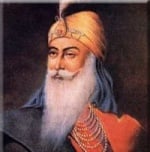Template:AOW146: Difference between revisions
Hari singh (talk | contribs) No edit summary |
Hari singh (talk | contribs) No edit summary |
||
| (3 intermediate revisions by the same user not shown) | |||
| Line 1: | Line 1: | ||
{{ | {{aowh2|Maharaja Ranjit Singh|Maharaja Ranjit Singh|birthday Nov 13}} | ||
[[File:Maharaja Ranjit Singh medium.jpg|thumb|150px|right|{{cs|'''Maharaja Ranjit Singh'''}}]] | [[File:Maharaja Ranjit Singh medium.jpg|thumb|150px|right|{{cs|'''[[Maharaja Ranjit Singh]]'''}}]] | ||
'''[[Maharaja Ranjit Singh]]''' ([[13th November]] [[1780]] - [[27 June]] [[1839]]) also called "Sher-e-Punjab" ("The Lion of Punjab") was the [[Sikh]] ruler of the sovereign country of [[Punjab]] and the [[Sikh Empire]] from about 1799. | '''[[Maharaja Ranjit Singh]]''' ([[13th November]] [[1780]] - [[27 June]] [[1839]]) also called "[[Sher-e-Punjab]]" ("[[The Lion of Punjab]]") was the [[Sikh]] ruler of the sovereign country of [[Punjab]] and the [[Sikh Empire]] from about 1799. Maharaja was born on [[November 13]], [[1780]] in [[Gujranwala]] in modern day [[Pakistan]], into the Sansi-Sandhawalia family. | ||
After several campaigns, his rivals accepted him as their leader, and he united the Sikh factions into one state and he took the title of {{wiki|Maharaja}} on April 12 1801 (to coincide with [[Baisakhi]] day), with [[Lahore]] serving as his capital from 1799. In 1802 he took control of the holy city of [[Amritsar]]. He brought law and order, yet was reluctant to use the death penalty. He stopped India's non-secular style and practises. He treated both [[Hindus]] and [[Muslims]] equally. He banned the discriminatory "{{wiki|jizya}}" tax on [[Hindus]] and [[Sikhs]] which had been imposed by the previous administration. | At the time, much of [[Punjab]] was ruled by the [[Sikhs]], who had divided the territory among factions known as [[Misl]]s. Ranjit Singh's father [[Maha Singh]] was the commander of the [[Sukerchakia]] misl and controlled a territory in west [[Punjab]] based around his headquarters at [[Gujranwala]]. Ranjit Singh succeeded his father at the young age of 12. | ||
After several campaigns, his rivals accepted him as their leader, and he united the Sikh factions into one state and he took the title of {{wiki|Maharaja}} on [[April 12]], [[1801]] <!----(to coincide with [[Baisakhi]] day), with [[Lahore]] serving as his capital from 1799. In 1802 he took control of the holy city of [[Amritsar]]. | |||
He brought law and order, yet was reluctant to use the death penalty. He stopped India's non-secular style and practises. He treated both [[Hindus]] and [[Muslims]] equally. He banned the discriminatory "{{wiki|jizya}}" tax on [[Hindus]] and [[Sikhs]] which had been imposed by the previous administration. The majority of Ranjit Singh's subjects were [[Muslim]] and had an intense loyalty towards him and his [[Sikh|Sikh's]]. This was once highlighted when the foreign minister of the [[Sikh Empire]], a Muslim named [[Fakir Azizuddin]], had a meeting with the British Governor-General. When {{wiki|George Eden, 1st Earl of Auckland}} asked Fakir Azizuddin which of the Maharaja's eye was missing, he replied: ''"the Maharaja is like the sun and sun has only one eye. The splendour and luminosity of his single eye is so much that I have never dared to look at his other eye."'' -----> {{aowf|Maharaja Ranjit Singh}} | |||
Latest revision as of 20:48, 11 November 2010
Maharaja Ranjit Singh (13th November 1780 - 27 June 1839) also called "Sher-e-Punjab" ("The Lion of Punjab") was the Sikh ruler of the sovereign country of Punjab and the Sikh Empire from about 1799. Maharaja was born on November 13, 1780 in Gujranwala in modern day Pakistan, into the Sansi-Sandhawalia family.
At the time, much of Punjab was ruled by the Sikhs, who had divided the territory among factions known as Misls. Ranjit Singh's father Maha Singh was the commander of the Sukerchakia misl and controlled a territory in west Punjab based around his headquarters at Gujranwala. Ranjit Singh succeeded his father at the young age of 12.
After several campaigns, his rivals accepted him as their leader, and he united the Sikh factions into one state and he took the title of Maharaja on April 12, 1801 .....More

